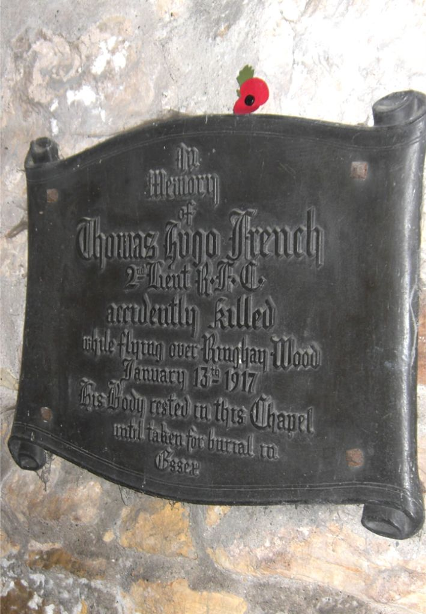Thomas Hugo French
Back to the Main Historical Society page
Back to the Barwicker Contents page
Thomas Hugo French
Pauline Robson
Barwicker No. 125
Winter 2017
Knowing my interest in the Gascoigne family and Lotherton Hall,
David Teal sent me details last year of Thomas Hugo French who was
killed during WWI whilst flying his plane over the woods at
Lotherton. I was intrigued and determined to find out more about this
man. Why was a plaque put in Lotherton chapel to commemorate
Thomas Hugo French?
He was born at Roxwell in Essex on the 21 st June 1895, the fourth son
of George Dennis French, farmer, and Alice (nee Snow) of Utling Hall
near Maldon in Essex.
He was educated at the King's School Canterbury from January 1904
to July 1911 where he was a member of the Officer Training Corps. He
played for the Cricket XI in 191 1, holding one of the school records.
He was said to be a "Fast and, at times erratic bowler but on his day
bowled well. A batsman of the wild type who loves the high balloon.
Good field. "
On leaving school he started a five year apprenticeship at Messrs
Davey, Paxman Ltd. who were engineers in Colchester and he joined
the company's athletic club and became a half mile champion.
On the 15th September 1914 Thomas enlisted at Westminster and was
Private PSI1498 in the 18th Battalion Royal Fusiliers (City of London
Regiment) (1 st Public Schools), University and Public School Corps.
He was five feet eleven inches tall and that he weighed 1611bs, It was
also noted that he had : "Slight flat feet. States he can march without
pain or fatigue."
Promoted to Lance Corporal on the 23rd November 1914 he then
requested that he revert to the rank of Private on the 28th May 1915.
He left Folkestone and crossed the channel with his battalion sailing on
the SS Princess Victoria at 8.15 am on the 14th of November 1915
destination being Boulogne. Due to floating mines off the harbour they
were diverted to Calais. He was promoted to unpaid Lance Corporal on
the 4th February 1916.
His efficient shooting was recognised and on 6th March 1916 he
applied for a commission, and returned from France on the 20th March
1916. He was posted to No. 4 Officer Cadet Battalion for officer
training on the 24 March 1916. He was commissioned as a Temporary
2nd Lieutenant in the Royal Flying Corps on the 5th August 1916.
Appointed as a Flying Officer on the 15th December 1916 he was then
posted to 46 Reserve Squadron based at RFC Bramham Moor the same
day. His rank of 2nd Lieutenant was confirmed on the 24th December
1916.
On the 10th January 1917 he witnessed the crash of a FE2d aircraft
from his base which killed Captain Rowland Burdon and his
passenger, Lieutenant Frederick Harry Turner. He attended the inquest
and upon giving evidence he said:
"Opening up the engine to go round again, and with the aircraft six to
eight feet off the ground, the pilot appeared to leave his climb too late
to clear a wood. A wing tip caught the top of the trees. The machine
then rose above the trees until it lost all speed, and then nose dived
into the ground, catching fire on impact. "
Three days later on the 13th January 1917 he took off from Bramham
Moor in a FE2d 1947 with a 250 hp Rolls Royce engine when he was
caught in a heavy snowstorm and was forced to descend. During his
descent in poor visibility his machine crashed into some trees in
Ringhay Wood at Aberford near Leeds and caught fire, killing him
instantly.
A court of inquiry into his death was held on the 14th January 1917.
His total effects amounted to £103. 1s. 0d
His body rested in Lotherton chapel before being taken to his home in
Essex for burial.
PAULINE ROBSON
Back to the top
Back to the Main Historical Society page
Back to the Barwicker Contents page

